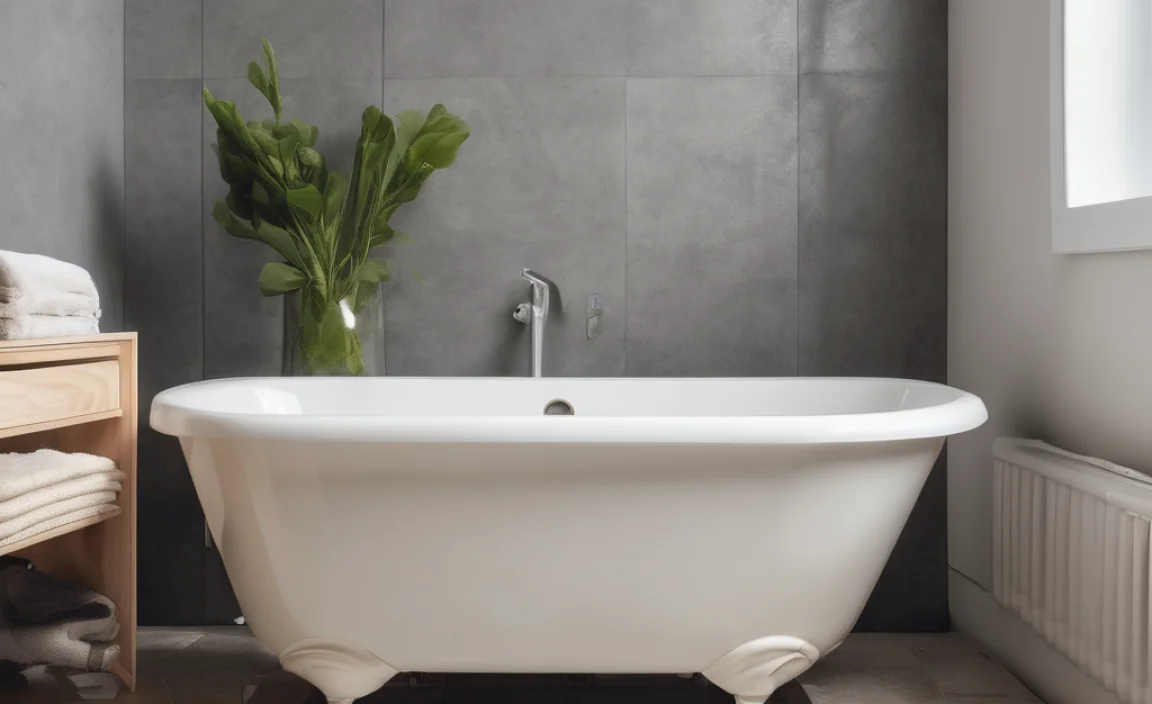Removing a bathtub without damaging your walls is totally doable! By carefully disconnecting the plumbing, gently loosening the tub, and using the right tools, you can avoid costly wall repairs. This guide will walk you through each step, so you can confidently complete this DIY project. Let’s get started and save you some time and money!
Taking out an old bathtub can feel like a huge job, especially when you’re worried about wrecking your bathroom walls. Many of us have been there, staring at that tub and wondering how to get it out without creating a demolition zone. The good news is, it’s absolutely possible to remove a bathtub without causing major damage. You just need a bit of patience and the right approach.
This guide will break down the process into simple, manageable steps. We’ll cover everything from prepping the area and disconnecting the plumbing, to safely removing the tub and cleaning up. By following these tips, you’ll be able to remove your old bathtub and get ready for your new one, without the stress of expensive wall repairs. Let’s dive in!
Tools and Materials You’ll Need

Before you start, gather all the necessary tools and materials. Having everything on hand will make the job smoother and faster.
- Safety Glasses: Protect your eyes from dust and debris.
- Gloves: Keep your hands safe from sharp edges and chemicals.
- Screwdrivers (various types): For removing screws and fasteners.
- Pliers: For gripping and bending pipes.
- Adjustable Wrench: For loosening and tightening plumbing connections.
- Utility Knife: For cutting caulk and sealant.
- Reciprocating Saw (Sawzall): For cutting the tub if necessary.
- Putty Knife or Scraper: For removing old caulk and adhesive.
- Bucket and Towels: For catching water and cleaning up spills.
- Cardboard or Drop Cloths: To protect your bathroom floor.
- Caulk Remover: To soften old caulk.
- Stud Finder: To locate wall studs before cutting.
- Pry Bar: For gently lifting and prying the tub loose.
- Hammer: For gentle tapping and prying.
- Trash Bags: For disposing of debris.
Step-by-Step Guide to Removing Your Bathtub

Follow these steps carefully to remove your bathtub without damaging your walls.
Step 1: Prepare the Area
Start by prepping the bathroom to protect it from damage.
- Cover the Floor: Lay down cardboard or drop cloths to protect your bathroom floor from scratches and dents.
- Clear the Area: Remove any items around the bathtub, such as shower curtains, bath mats, and toiletries.
- Ventilate the Room: Open windows or turn on a ventilation fan to keep the air fresh.
Step 2: Turn Off the Water Supply
Before you start disconnecting any plumbing, make sure the water is turned off to prevent flooding.
- Locate the Shut-Off Valves: Find the shut-off valves for the hot and cold water lines that supply the bathtub. These are usually located near the bathtub or in an adjacent room.
- Turn Off the Valves: Turn both valves clockwise until they are completely closed.
- Test the Water: Turn on the bathtub faucet to make sure the water is completely shut off. If water continues to flow, you may need to turn off the main water supply to your house.
Step 3: Disconnect the Drain and Overflow
Carefully disconnect the drain and overflow pipes to free the bathtub from the plumbing system.
- Access the Drain: You may need to access the drain from underneath the bathtub or through an access panel in an adjacent wall or ceiling.
- Loosen the Drainpipe: Use an adjustable wrench to loosen the nut connecting the drainpipe to the bathtub drain. Have a bucket and towels ready to catch any remaining water.
- Disconnect the Overflow: Remove the overflow plate and disconnect the overflow pipe from the bathtub.
- Remove the Drain: Once the pipes are disconnected, carefully remove the drain from the bathtub.
Step 4: Remove the Faucet and Spout
Detach the faucet and spout from the bathtub to make it easier to maneuver.
- Locate the Faucet Connections: Look for the connections where the faucet is attached to the water supply pipes.
- Disconnect the Faucet: Use an adjustable wrench to disconnect the faucet from the water supply pipes. Be careful not to damage the pipes.
- Remove the Spout: Unscrew or detach the spout from the bathtub.
Step 5: Cut the Caulk
Use a utility knife to cut through the caulk around the edges of the bathtub.
- Score the Caulk: Use a sharp utility knife to score along the caulk where the bathtub meets the wall and floor.
- Apply Caulk Remover: If the caulk is old and hard, apply a caulk remover to soften it. Follow the instructions on the caulk remover.
- Remove the Caulk: Use a putty knife or scraper to carefully remove the caulk from the edges of the bathtub.
Step 6: Loosen the Bathtub
Gently loosen the bathtub from its position.
- Check for Fasteners: Look for any screws, nails, or clips that may be holding the bathtub in place. Remove them with a screwdriver or pliers.
- Use a Pry Bar: Insert a pry bar between the bathtub and the wall or floor. Gently pry the bathtub loose, working your way around the edges. Be careful not to damage the walls.
- Tap with a Hammer: If the bathtub is stuck, gently tap the pry bar with a hammer to help loosen it.
Step 7: Remove the Bathtub
Carefully remove the bathtub from the bathroom.
- Lift the Bathtub: With the bathtub loosened, carefully lift it out of its position. You may need a helper to lift the bathtub, especially if it is heavy.
- Maneuver the Bathtub: Tilt the bathtub on its side or end to maneuver it through the bathroom doorway.
- Protect the Walls: Use cardboard or blankets to protect the walls and door frames as you move the bathtub.
- Dispose of the Bathtub: Take the old bathtub outside and dispose of it properly. You may need to take it to a recycling center or landfill.
Step 8: Clean Up
Clean the area where the bathtub was located.
- Remove Debris: Use a broom and dustpan to remove any debris from the area.
- Scrape Away Residue: Use a putty knife or scraper to remove any remaining caulk or adhesive from the walls and floor.
- Clean the Surfaces: Wipe down the walls and floor with a damp cloth to remove any dirt or grime.
Different Types of Bathtubs and How to Handle Them

Bathtubs come in various shapes and materials, each requiring slightly different removal techniques. Here’s a quick guide:
- Acrylic Bathtubs: Lightweight and easier to maneuver, but be careful not to scratch the surface during removal.
- Cast Iron Bathtubs: Very heavy and require extra caution. Enlist help and use proper lifting techniques.
- Steel Bathtubs: Lighter than cast iron but can still be bulky. Watch out for sharp edges.
- Clawfoot Bathtubs: Can be tricky to move due to their feet. Detach the feet if possible, or use furniture sliders to protect your floor.
- Corner Bathtubs: Often larger and more awkward to handle. Plan your removal path carefully.
Dealing with Difficult Situations

Sometimes, removing a bathtub can present unexpected challenges. Here are some tips for handling common issues:
- Stubborn Caulk: Use a heat gun on low setting to soften the caulk before scraping.
- Rusted Fasteners: Apply penetrating oil and let it sit for a few hours before attempting to remove them.
- Tight Spaces: If you’re struggling to maneuver the bathtub, consider cutting it into smaller pieces using a reciprocating saw. Be sure to wear safety glasses and gloves.
- Damaged Walls: If you accidentally damage the walls, patch them with drywall compound and repaint.
Cutting the Bathtub as a Last Resort

If you absolutely can’t remove the bathtub in one piece, you may need to cut it into smaller, more manageable sections. This should be a last resort, as it can be time-consuming and create a lot of dust and debris.
- Prepare the Area: Cover the surrounding area with plastic sheeting to contain the dust. Wear safety glasses, gloves, and a dust mask.
- Use a Reciprocating Saw: Use a reciprocating saw (Sawzall) with a metal-cutting blade to cut the bathtub into sections.
- Cut Carefully: Cut slowly and carefully, following a straight line. Avoid cutting into the wall studs or plumbing pipes.
- Remove the Sections: As you cut each section, remove it from the bathroom and dispose of it properly.
Tips to Avoid Damaging Your Walls
Here are some extra tips to help you avoid damaging your walls during bathtub removal:
- Take Your Time: Don’t rush the process. Work slowly and carefully to avoid mistakes.
- Use Padding: Use cardboard or blankets to protect the walls from scratches and dents.
- Be Gentle: Avoid using excessive force when prying or lifting the bathtub.
- Inspect the Walls: Before you start, inspect the walls for any existing damage. Take photos so you can document any changes.
- Ask for Help: If you’re not comfortable removing the bathtub yourself, consider hiring a professional.
Table of Common Bathtub Materials
| Material | Pros | Cons | Removal Difficulty |
|---|---|---|---|
| Acrylic | Lightweight, Durable, Easy to clean | Can scratch, Less heat retention | Easy |
| Cast Iron | Excellent heat retention, Durable | Very heavy, Can chip | Difficult |
| Steel | Lightweight, Affordable | Poor heat retention, Can rust | Medium |
| Fiberglass | Lightweight, Affordable | Less durable, Can flex | Easy |
Cost Considerations
Removing a bathtub yourself can save you money, but it’s essential to factor in all potential costs.
- DIY Removal: The primary cost is your time. You might spend $50-$100 on tools and supplies like caulk remover, gloves, and a utility knife.
- Professional Removal: Hiring a professional can cost anywhere from $300 to $800, depending on the complexity of the job and your location.
- Potential Repairs: Always budget for potential repairs. Fixing minor wall damage might cost an additional $50-$200.
- Disposal Fees: Disposing of the old bathtub can cost $25-$75, depending on your local waste disposal rates.
FAQ: Removing a Bathtub
1. How long does it take to remove a bathtub?
Removing a bathtub can take anywhere from 2 to 6 hours, depending on your experience level and the complexity of the installation.
2. Do I need a permit to remove a bathtub?
In most cases, you do not need a permit to remove a bathtub. However, it’s always a good idea to check with your local building department to be sure.
3. Can I remove a bathtub by myself?
While it’s possible to remove a bathtub by yourself, it’s much easier and safer to have a helper, especially if the bathtub is heavy.
4. What should I do with the old bathtub?
You can dispose of the old bathtub at a recycling center or landfill. Some recycling centers may even pay you for the metal.
5. How do I prevent mold growth after removing the bathtub?
Clean the area thoroughly with a mold and mildew cleaner. Make sure the area is dry before installing a new bathtub or finishing the space.
6. What if the bathtub is glued to the floor?
Use a pry bar and hammer to gently break the adhesive bond. Work slowly and carefully to avoid damaging the floor.
7. Is it worth hiring a professional to remove my bathtub?
If you’re not comfortable with plumbing or demolition work, or if you’re concerned about damaging your walls, it’s worth hiring a professional to remove your bathtub.
Conclusion
Removing a bathtub without destroying your walls might seem challenging, but with the right tools, a bit of patience, and this step-by-step guide, you can absolutely handle it. Remember to take your time, protect your bathroom, and follow each step carefully. By doing so, you’ll not only save money but also gain the satisfaction of completing a successful DIY project. So, grab your tools and get started—your new, improved bathroom awaits!

